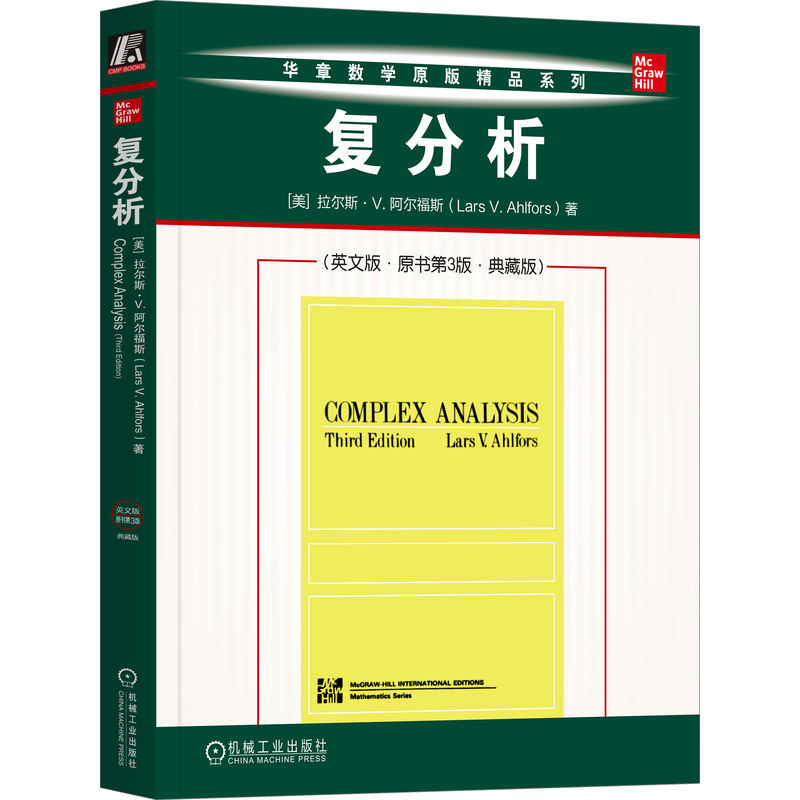复分析(英文版·原书第3版·典藏版) / 华章数学原版精品系列
定价:¥119.00
作者: [美]拉尔斯·V.阿尔福斯
出版时间:2022-03
最新印次日期:2023-3
出版社:机械工业出版社
试读
- 机械工业出版社
- 9787111701026
- 1-2
- 429237
- 48269994-9
- 平装
- 16开
- 2022-03
- 202
- 340
- 理学
- 数学类
- 数学与应用数学
- 本科
作者简介
内容简介
全书共分成8章,主要包括:复数、复函数、作为映射的解析函数、复积分、级数与乘积展开、共形映射、狄利克雷问题、椭圆函数以及全局解析函数。此外,大部分章节后都有练习,便于学生掌握书中内容,其中加上“*”号的练习供学有余力的学生选做。本书假定读者具备大学二年级的数学基础,可作为高等院校高年级本科生以及研究生的教材和参考书。
目录
Preface
CHAPTER 1 COMPLEX NUMBERS1
1 The Algebra of Complex Numbers1
1.1 Arithmetic Operations1
1.2 Square Roots3
1.3 Justification4
1.4 Conjugation, Absolute Value6
1.5 Inequalities9
2 The Geometric Representation of Complex Numbers12
2.1 Geometric Addition and Multiplication12
2.2 The Binomial Equation15
2.3 Analytic Geometry17
2.4 The Spherical Representation18
CHAPTER 2 COMPLEX FUNCTIONS21
1 Introduction to the Concept of Aaalytic Function21
1.1 Limits and Continuity22
1.2 Aaalytic Functions24
1.3 Polynomials28
1.4 Rational Functions30
2 Elementary Theory of Power Serices 33
2.1 Sequences33
2.2 Serues35
2.3 Uniform Convergence35
2.4 Power Series38
2.5 Abel's Limit Theorem41
3 The Exponential and Trigonometric Functions42
3.1 The Exponential42
3.2 The Trigonometric Functions43
3.3 The Periodicity44
3.4 The Logarithm46
CHAPTER 3 ANALYTIC FUNCTIONS AS MAPPINGS49
1 Elementary Point Set Topology50
1.1 Sets and Elements50
1.2 Metric Spaces51
1.3 Connectedness54
1.4 Connectedness59
1.5 Continuous Functions63
1.6 Topoliogical Spaces 66
2 Conformality
2.1 Arcs and Closed Curves67
2.2 Analytic Function in Regions69
2.3 Conformal Mapping73
2.4 Length and Area75
3 Linear Transformations76
3.1 The Linear Group76
3.2 The Cross Ratio78
3.3 Symmetry80
3.4 Oriented Circles83
3.5 Families of Circles84
4 Elementary Conformal Mappings89
4.1 The Use of Level Curves89
4.2 A Survey of Elementary Mappings93
4.3 Elementary Riemann Surfaces 97
CHAPTER 4 COMPLEX INTEGRATION101
1 Fundamental Theorems101
1.1 Line Integrals101
1.2 Rectifiable Arcs104
1.3 Line Integrals as Functions of Ares105
1.4 Cauchy's Theorem for a Recatangle109
1.5 Cauchy's Theorem in a Disk112
2 Cauchy's Integral Formula114
2.1 The Index of a Point with Respect to a Closed Curve114
2.2 The Integral Formula118
2.3 Higher Dervatives120
3 Local Properties of Aaalytic Functions124
3.1 Removable Singularites. Taylor's Theorem124
3.2 Zeros and Poles126
3.3 The Local Mapping130
3.4 The Mazimum Principle133
4 The General Form of Cauchy's Theorem137
4.1 Chains and Cycles 137
4.2 Siple Connectivity138
4.3 Homology141
4.4 The General Statement of Cauchy's Theorem141
4.5 Proof of Cauchy's Theorem142
4.6 Locally Exact Differentials144
4.7 Multiply Connected Regions146
5 The Calculus of Residues148
5.1 The Residue Theorem148
5.2 The Argument Principle152
5.3 Evaluation of Definite Integrals154
6 Harmonic Functions162
6.1 Definition and Basic Properties162
6.2 The Mean-value Property165
6.3 Poisson's Formula168
6.4 Schwarz's Theorem 168
6.5 The Reflection Principle172
CHAPTER 5 SERIES AND PRODUCT DEVELOPMENTS175
1 Power Serices Expansions175
1.1 Weierstrass's Theorem175
1.2 The Taylor Series179
1.3 The Laurent Series184
2 Partial Fractions and Factorzation187
2.1 Partial Fractions187
2.2 Infinite Products191
2.3 Canonical Products 193
2.4 The Gamma Function198
2.5 Stirling's Formula201
3 Entire Functions206
3.1 Jensen's Formula207
3.2 Hadamard's Theorem208
4 The Riemann Zeta Function212
4.1 The Product Development213
4.2 Extension of (s)to the Whole Plane214
4.3 The Functioal Equation216
4.4 The Zeros of the Zeta Functaion218
5 Normal Families 219
5.1 Equicontinuity219
5.2 Normality and Compactness220
5.3 Arzela's Theorem222
5.4 Families of Analytic Functions223
5.5 The Claaical Definition225
CHAPTER 6 CONFORMAL MAPPUNG. DIRICHLET'S PROBLEM229
1 The Riemann Mapping Throrem229
1.1 Statement and Proof229
1.2 Boundary Behavior232
1.3 Use of the Reflection Principle233
1.4 Analytic Arcs234
2 Conformal Mapping of Polygons235
2.1 The Behavior at an Angle 235
2.2 The Schwarz-Christoffel Formula236
2.3 Mapping on a Rectangle238
2.4 The Triangle Functions of Schwarz241
3 A Closer Look at Harmonic Functions241
3.1 Functions with the Mean-value Property242
3.2 Harnack's Principle 243
4 The Dirichlet Problem245
4.1 Subharmonic Functions245
4.2 Solution of Dirchlet's Problem248
5 Canonical Mappings of Multiply Connected Regions251
5.1 Harmonic Measures252
5.2 Green's Function 257
5.3 Parallel Slit Regions 259
CHAPTER 7 ELLIPTIC FUNCTIONS263
1 Simply Periodic Functions263
1.1 Representation by Exponentials263
1.2 The Fourier Development264
1.3 Functions of Finite Order264
2 Doubly Periodic Functions265
2.1 The Period Module265
2.2 Unimodular Transformations266
2.3 The Canonical Basis268
2.4 General Properties of Elliptic Functions270
3 The Weierstrass Theory272
3.1 Tht Eeierstrass g-function272
3.2 Tht Functions g(z) and s(z)273
3.3 Tht Differential Equation275
3.4 Tht Modular Function l(t)277
3.5 Tht Conformal Mapping by l(t)279
CHAPTER 8 GLOBAL ANALYTIC FUNCTIONS283
1 Analytic Contrnuation283
1.1 The Weierstrass Theory283
1.2 Germs and Sheaves284
1.3 Sections and Riemann Surfaces287
1.4 Analytic Continuations along Arcs289
1.5 Homotopic Curves291
1.6 The Monodromy Theorem295
1.7 Branch Points297
2 Algebraic Functions300
2.1 The Resultant of Two Polynomials300
2.2 Definition and Properties of Algebraic Function301
2.3 Behavior at the Critical Points304
3 Picard's Theorm306
3.1 Lacunary Values307
4 Linear Differentail Equations308
4.1 Ordinary Points309
4.2 Regular Singular Points311
4.3 Solutions at Infinity313
4.4 The Hypergemetric Differential Equation315
4.5 Riemann's Point of View318
Index323
CHAPTER 1 COMPLEX NUMBERS1
1 The Algebra of Complex Numbers1
1.1 Arithmetic Operations1
1.2 Square Roots3
1.3 Justification4
1.4 Conjugation, Absolute Value6
1.5 Inequalities9
2 The Geometric Representation of Complex Numbers12
2.1 Geometric Addition and Multiplication12
2.2 The Binomial Equation15
2.3 Analytic Geometry17
2.4 The Spherical Representation18
CHAPTER 2 COMPLEX FUNCTIONS21
1 Introduction to the Concept of Aaalytic Function21
1.1 Limits and Continuity22
1.2 Aaalytic Functions24
1.3 Polynomials28
1.4 Rational Functions30
2 Elementary Theory of Power Serices 33
2.1 Sequences33
2.2 Serues35
2.3 Uniform Convergence35
2.4 Power Series38
2.5 Abel's Limit Theorem41
3 The Exponential and Trigonometric Functions42
3.1 The Exponential42
3.2 The Trigonometric Functions43
3.3 The Periodicity44
3.4 The Logarithm46
CHAPTER 3 ANALYTIC FUNCTIONS AS MAPPINGS49
1 Elementary Point Set Topology50
1.1 Sets and Elements50
1.2 Metric Spaces51
1.3 Connectedness54
1.4 Connectedness59
1.5 Continuous Functions63
1.6 Topoliogical Spaces 66
2 Conformality
2.1 Arcs and Closed Curves67
2.2 Analytic Function in Regions69
2.3 Conformal Mapping73
2.4 Length and Area75
3 Linear Transformations76
3.1 The Linear Group76
3.2 The Cross Ratio78
3.3 Symmetry80
3.4 Oriented Circles83
3.5 Families of Circles84
4 Elementary Conformal Mappings89
4.1 The Use of Level Curves89
4.2 A Survey of Elementary Mappings93
4.3 Elementary Riemann Surfaces 97
CHAPTER 4 COMPLEX INTEGRATION101
1 Fundamental Theorems101
1.1 Line Integrals101
1.2 Rectifiable Arcs104
1.3 Line Integrals as Functions of Ares105
1.4 Cauchy's Theorem for a Recatangle109
1.5 Cauchy's Theorem in a Disk112
2 Cauchy's Integral Formula114
2.1 The Index of a Point with Respect to a Closed Curve114
2.2 The Integral Formula118
2.3 Higher Dervatives120
3 Local Properties of Aaalytic Functions124
3.1 Removable Singularites. Taylor's Theorem124
3.2 Zeros and Poles126
3.3 The Local Mapping130
3.4 The Mazimum Principle133
4 The General Form of Cauchy's Theorem137
4.1 Chains and Cycles 137
4.2 Siple Connectivity138
4.3 Homology141
4.4 The General Statement of Cauchy's Theorem141
4.5 Proof of Cauchy's Theorem142
4.6 Locally Exact Differentials144
4.7 Multiply Connected Regions146
5 The Calculus of Residues148
5.1 The Residue Theorem148
5.2 The Argument Principle152
5.3 Evaluation of Definite Integrals154
6 Harmonic Functions162
6.1 Definition and Basic Properties162
6.2 The Mean-value Property165
6.3 Poisson's Formula168
6.4 Schwarz's Theorem 168
6.5 The Reflection Principle172
CHAPTER 5 SERIES AND PRODUCT DEVELOPMENTS175
1 Power Serices Expansions175
1.1 Weierstrass's Theorem175
1.2 The Taylor Series179
1.3 The Laurent Series184
2 Partial Fractions and Factorzation187
2.1 Partial Fractions187
2.2 Infinite Products191
2.3 Canonical Products 193
2.4 The Gamma Function198
2.5 Stirling's Formula201
3 Entire Functions206
3.1 Jensen's Formula207
3.2 Hadamard's Theorem208
4 The Riemann Zeta Function212
4.1 The Product Development213
4.2 Extension of (s)to the Whole Plane214
4.3 The Functioal Equation216
4.4 The Zeros of the Zeta Functaion218
5 Normal Families 219
5.1 Equicontinuity219
5.2 Normality and Compactness220
5.3 Arzela's Theorem222
5.4 Families of Analytic Functions223
5.5 The Claaical Definition225
CHAPTER 6 CONFORMAL MAPPUNG. DIRICHLET'S PROBLEM229
1 The Riemann Mapping Throrem229
1.1 Statement and Proof229
1.2 Boundary Behavior232
1.3 Use of the Reflection Principle233
1.4 Analytic Arcs234
2 Conformal Mapping of Polygons235
2.1 The Behavior at an Angle 235
2.2 The Schwarz-Christoffel Formula236
2.3 Mapping on a Rectangle238
2.4 The Triangle Functions of Schwarz241
3 A Closer Look at Harmonic Functions241
3.1 Functions with the Mean-value Property242
3.2 Harnack's Principle 243
4 The Dirichlet Problem245
4.1 Subharmonic Functions245
4.2 Solution of Dirchlet's Problem248
5 Canonical Mappings of Multiply Connected Regions251
5.1 Harmonic Measures252
5.2 Green's Function 257
5.3 Parallel Slit Regions 259
CHAPTER 7 ELLIPTIC FUNCTIONS263
1 Simply Periodic Functions263
1.1 Representation by Exponentials263
1.2 The Fourier Development264
1.3 Functions of Finite Order264
2 Doubly Periodic Functions265
2.1 The Period Module265
2.2 Unimodular Transformations266
2.3 The Canonical Basis268
2.4 General Properties of Elliptic Functions270
3 The Weierstrass Theory272
3.1 Tht Eeierstrass g-function272
3.2 Tht Functions g(z) and s(z)273
3.3 Tht Differential Equation275
3.4 Tht Modular Function l(t)277
3.5 Tht Conformal Mapping by l(t)279
CHAPTER 8 GLOBAL ANALYTIC FUNCTIONS283
1 Analytic Contrnuation283
1.1 The Weierstrass Theory283
1.2 Germs and Sheaves284
1.3 Sections and Riemann Surfaces287
1.4 Analytic Continuations along Arcs289
1.5 Homotopic Curves291
1.6 The Monodromy Theorem295
1.7 Branch Points297
2 Algebraic Functions300
2.1 The Resultant of Two Polynomials300
2.2 Definition and Properties of Algebraic Function301
2.3 Behavior at the Critical Points304
3 Picard's Theorm306
3.1 Lacunary Values307
4 Linear Differentail Equations308
4.1 Ordinary Points309
4.2 Regular Singular Points311
4.3 Solutions at Infinity313
4.4 The Hypergemetric Differential Equation315
4.5 Riemann's Point of View318
Index323










